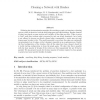Free Online Productivity Tools
i2Speak
i2Symbol
i2OCR
iTex2Img
iWeb2Print
iWeb2Shot
i2Type
iPdf2Split
iPdf2Merge
i2Bopomofo
i2Arabic
i2Style
i2Image
i2PDF
iLatex2Rtf
Sci2ools
TCS
2008
2008
Cleaning a network with brushes
Following the decontamination metaphor for searching a graph, we introduce a cleaning process, which is related to both the chip-firing game and edge searching. Brushes (instead of chips) are placed on some vertices and, initially, all the edges are dirty. When a vertex is `fired', each dirty incident edge is traversed by only one brush, cleaning it, but a brush is not allowed to traverse an already cleaned edge; consequently, a vertex may not need degree-many brushes to fire. The model presented is one where the edges are continually recontaminated, say by algae, so that cleaning is regarded as an on-going process. Ideally, the final configuration of the brushes, after all the edges have been cleaned, should be a viable starting configuration to clean the graph again. We show that this is possible with the least number of brushes if the vertices are fired sequentially but not if fired in parallel. We also present bounds for the least number of brushes required to clean graphs in...
Brushes | Cleaning | Edge | TCS 2008 | Theoretical Computer Science |
| Added | 15 Dec 2010 |
| Updated | 15 Dec 2010 |
| Type | Journal |
| Year | 2008 |
| Where | TCS |
| Authors | Margaret-Ellen Messinger, Richard J. Nowakowski, Pawel Pralat |
Comments (0)

